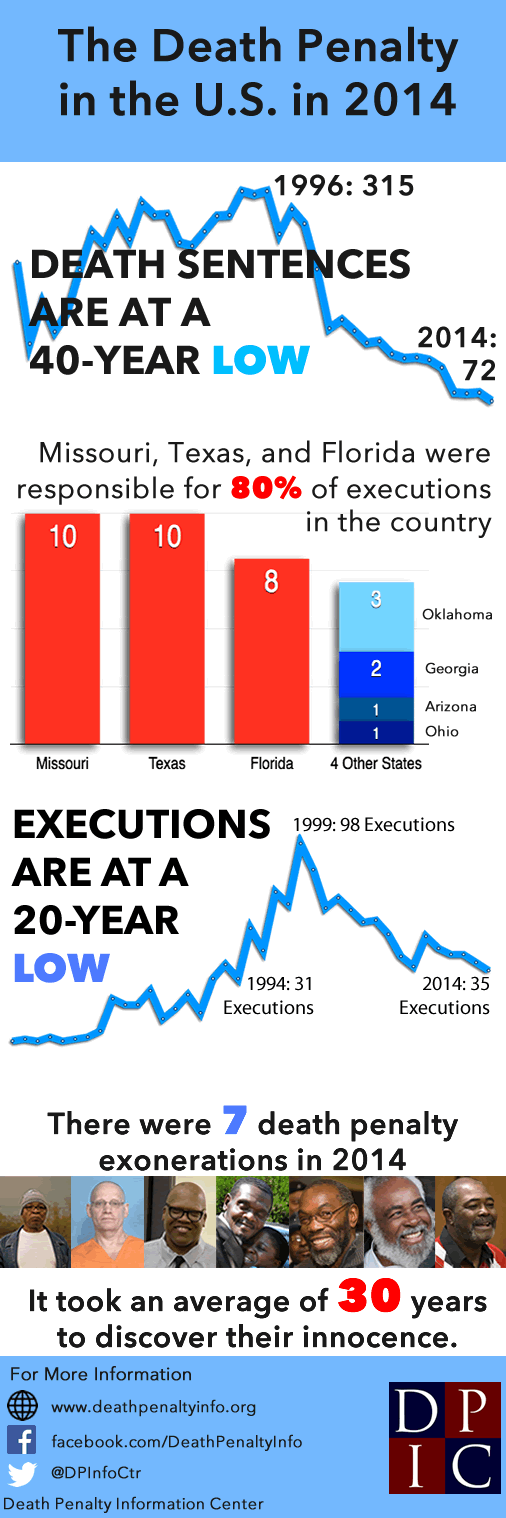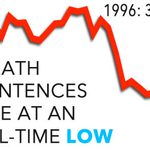The Death Penalty in 2014: Year End Report
Posted on Dec 18, 2014
- PRESS RELEASE
- INFOGRAPHIC: "The Death Penalty in the U.S."
- EDITORIALS: Newspapers Around the Country Echoed Themes in DPIC's Year End Report
- 2014 SENTENCING DATA
- MEDIA COVERAGE
- GRAPHICS FOR POSTING ON SOCIAL MEDIA

PRESS RELEASE Top
FOR IMMEDIATE RELEASE
DEATH PENALTY 2014: FEWEST EXECUTIONS IN 20 YEARS
FEWEST DEATH SENTENCES IN 40 YEARS
Seven Death Row Inmates Exonerated, Highest in Five Years
(Washington, D.C.) With 35 executions this year, 2014 marks the fewest people put to death since 1994, according to a report released today by the Death Penalty Information Center (DPIC). The 72 new death sentences in 2014[1] is the lowest number in the modern era of the death penalty, dating back to 1974. Executions and sentences have steadily decreased, as Americans have grown more skeptical of capital punishment. The states’ problems with lethal injections also contributed to the drop in executions this year.
Executions decreased 10% compared to 2013 – from 39 last year to 35 this year – continuing an overall decline since 1999, when there were 98 executions. The number of states carrying out executions – seven – was the lowest in 25 years. Just three states – Texas, Missouri, and Florida – accounted for 80% of the executions. For the first time in 17 years, Texas did not lead the country in executions, being tied with Missouri at 10.
Death sentences — a more current barometer than executions — have declined by 77% since 1996, when there were 315. There were 79 death sentences last year. This is the fourth year in a row that there have been fewer than 100 death sentences.
“The relevancy of the death penalty in our criminal justice system is seriously in question when 43 out of our 50 states do not apply the ultimate sanction,” said Richard Dieter, DPIC’s Executive Director and the author of the report. “The U.S. will likely continue with some executions in the years ahead, but the rationale for such sporadic use is far from clear.”
Seven people who had been on death row were exonerated in 2014, the most since 2009. Three men in Ohio were cleared of all charges 39 years after their convictions, the longest time of any death row exonerees. Two others in North Carolina were freed after 30 years in confinement. Since 1973, 150 people have been exonerated and freed from death row.
Individual state developments illustrate the growing isolation of death penalty use:
· The number of executions has declined in 11 of the past 15 years. In 1999, 20 states carried out executions; in 2014, only 7 states did so.
· For the seventh year in a row, Texas had fewer than a dozen death sentences, a sharp decline from 1999, when it had 48.[2]
· California (14) and Florida (11) provided 35% of the death sentences in the country.
· Washington Governor Jay Inslee announced that no executions would take place while he is governor, joining the governors of Oregon and Colorado in halting executions.
· In California, a federal judge declared the state’s death penalty unconstitutional.
Mental disabilities loomed as an emerging issue in 2014. The Supreme Court struck down Florida’s restrictive standards for determining intellectual disability in capital cases. The pending execution of a paranoid schizophrenic inmate in Texas (Scott Panetti) drew opposition from evangelical leaders, mental health professionals, and many others. A federal court stayed the execution with just hours to spare.
###
The Death Penalty Information Center (www.deathpenaltyinfo.org) is a non-profit organization serving the media and the public with analysis and information on issues concerning capital punishment. DPIC was founded in 1990 and prepares in-depth reports, issues press releases, conducts briefings for the media, and serves as a resource to those working on this issue.
[1] Two weeks remain in 2014, but based on DPIC’s tracking of pending cases, the total number of death sentences will likely remain at 72, with an increase of one or two still possible, still the lowest number in 40 years.
[2] A Texas-specific report is being released by another organization: see “Texas Death Penalty Developments in 2014: The Year in Review” at http://tcadp.org/.
INFOGRAPHIC: “The Death Penalty in the U.S.” Top

EDITORIALS: Newspapers Around the Country Echoed Themes in DPIC’s Year End Report Top
DPIC’s 2014 Year End Report was featured in numerous editorials since its release on December 18, including:
- THE NEW YORK TIMES: “Thirty-five people were put to death in 2014, the fewest in 20 years, according to a report last month by the Death Penalty Information Center.…[W]hile the death penalty may be increasingly infrequent, it is all too often a brutal end to a brutal life.…The people executed in recent years were not the ‘worst of the worst’ — as many death-penalty advocates like to imagine — but those who were too poor, mentally ill or disabled to avoid it.”
- THE WASHINGTON POST: “According to a year-end count from the Death Penalty Information Center, the country sentenced 72 people to death this year, the fewest number in 40 years, down from a high of 315 in 1996.…All states should end the death penalty within their borders. The risk of executing the innocent, evidenced by the seven men who were exonerated this year, is unacceptable. The financial cost of administering death penalty systems is also too high. Either consideration overwhelms arguments about the punishment’s usefulness as a crime deterrent.”
- THE CHICAGO SUN-TIMES: “[Last year, only 35 inmates were put to death, according to an annual study by the Death Penalty Information Center.…voters are coming to realize capital punishment isn’t applied only to those truly guilty of the most heinous crimes. In fact, all too many of those sentenced to die turned out to be innocent.”
- THE KANSAS CITY STAR: “[T]he annual report about all of this from the Death Penalty Information Center shows that Missouri, Texas and Florida accounted for 80 percent of the executions in 2014.…Reasonable alternatives to the death penalty exist, including, in some cases, life in prison without parole. These alternatives, which are much less expensive to operate, would prevent the execution of some people who aren’t guilty of the crimes they’re convicted of committing.”
- THE CHICAGO TRIBUNE: “[T]he Death Penalty Information Center says in its annual report, 35 people have been executed in the United States — down from 98 just 15 years ago.…Capital punishment is not going to disappear from this country anytime soon. But the more experience Americans have with it, the less they like it.”
- THE TOLEDO BLADE: “In 2014, U.S. executions fell to a 20-year low — and botched executions in Ohio and other states were partly responsible. …the Death Penalty Information Center reports. …As states continue to experiment with lethal drug cocktails, Ohioans need to know whether executions here can proceed properly. Sadly, the administration is making that practically impossible.”
(Editorial, “Ways to make the death penalty more fair and humane,” Washington Post, December 31, 2014; Editorial, “Shifting Politics on the Death Penalty,” New York Times, January 5, 2015; Editorial, “America turning away from death penalty: Editorial,” Chicago Sun-Times, December 21, 2014; Editorial, “Instead of defying a national trend, Missouri could lead by ending the death penalty,” Kansas City Star, January 2, 2015; Editorial, “The welcome decline of the death penalty,” Chicago Tribune, December 19, 2014; Editorial, “Deathly Silence,” Toledo Blade, January 5, 2015).
2014 SENTENCING DATA Top
See 2014 Sentencing Data by Name, Race, and County.
MEDIA COVERAGE Top
Read media coverage of the 2014 Year End Report.
GRAPHICS FOR POSTING ON SOCIAL MEDIA Top
(Right click on “Download” and select “Save Linked File” or “Save Target File”)

Twitter: Download (GIF)
Facebook: Download (GIF)